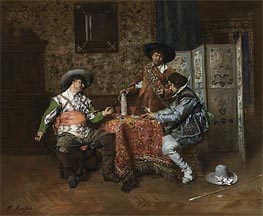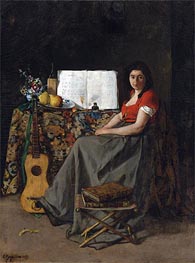
Ferdinand Victor Leon Roybet Painting Reproductions 1 of 1
1840-1920
French Academic Classicism Painter
Ferdinand Roybet occupies a fascinating niche in the landscape of 19th-century French art. Born on April 12, 1840, in the southern town of Uzès, he was immersed from an early age in a region steeped in diverse cultural influences and historical upheavals. His father, Louis Charles Florent Roybet, possibly a café owner and liquor manufacturer, moved the family to Lyon in 1846. It was there that young Ferdinand's artistic inclinations began to take root.
At just thirteen, he enrolled in the École des Beaux-Arts de Lyon, studying under the etcher and engraver Joseph Vibert. This early education in the meticulous craft of engraving likely honed his eye for detail. During this time, he befriended Antoine Vollon, a Realist painter whose influence would echo throughout Roybet's career. Yet, the confines of formal training couldn't contain his restless spirit. He left Vibert's studio to pursue independent studies, drawing inspiration from the local museum's collections and the countryside's natural beauty.
By 1863, Roybet had sold a significant canvas depicting "St. Irene the Martyr," affirming his path as a painter. The following year brought personal upheaval with the death of his father. He relocated to Paris with his wife, Amélie Louise Rollion, and their young child. The bustling capital offered new opportunities, and Vollon, already established there, helped him navigate the vibrant Parisian art scene.
Roybet made his Salon debut in 1865, but his first major acclaim came a year later with "Fou sous Henri III" - "The Jester of Henri III." This work captured the enigmatic figure of Chicot, the jester to King Henri III, rendered with vivid color and theatrical flair. The painting won an award at the Salon and was purchased by Princess Mathilde Bonaparte, Napoleon's niece. Critics took notice; even the often skeptical Emile Zola described it as an "honest painting," despite referring to Chicot as a "clothed satyr." Roybet's reputation was on the ascent.
The late 1860s saw him solidify his standing, but the Franco-Prussian War in 1870 disrupted his trajectory. Opting to leave France, he traveled to Holland, immersing himself in the works of Frans Hals, Rembrandt, and Jacob Jordaens. Their influence, especially in the play of light and shadow, left an indelible mark on his style. Returning to Paris in 1872, he soon embarked on another journey, this time to Algeria. The North African landscapes and cultures expanded his artistic horizons, leading some to label him an Orientalist - though such a term only scratches the surface of his diverse oeuvre.
Throughout the 1870s and 1880s, Roybet balanced anecdotal genre scenes with portraiture. His travels to Spain and Italy deepened his appreciation for the Old Masters, informing his depictions of cavaliers, musketeers, and Spanish nobility. Paintings like "The Connoisseur" don't just romanticize the past; they probe the very act of appreciating art. Yet he wasn't confined to idealized visions. Works such as "The Gypsy Woman" reveal a sensitivity to the hardships endured by society's margins, capturing fatigue and dignity in equal measure.
Portraiture provided both an artistic challenge and financial stability. Roybet painted figures like Madame Olympe Hériot, wife of a department store magnate, and the eccentric Count Robert de Montesquiou, whose flamboyance inspired literary characters. His success wasn't limited to France; the American art market embraced his work, with collectors like Cornelius Vanderbilt acquiring his paintings. An ink drawing inscribed with gratitude to "the great people of America" hints at his international connections.
Around 1880, he began mentoring students, among them Juana Romani, a talented painter and model. His "Portrait of Juana Romani" marked a significant return to the Salon in 1892, showcasing an evolution toward a more emotive, symbolist approach. The following year, his "Charles le Téméraire entrant à cheval dans l'église de Nesle" earned a medal of honor at the Salon, and he was appointed a Chevalier of the Legion of Honor - later elevated to an officer in 1900.
In his later years, Roybet turned increasingly toward religious subjects. Paintings like "Head of John the Baptist" demonstrate a contemplation of spirituality and mortality, rendered without sensationalism. This shift might reflect personal introspection or a response to the societal upheavals of his time, including the devastating impact of World War I.
Ferdinand Roybet passed away at his Paris home on April 11, 1920, just a day shy of his eightieth birthday. The following year, the Salon honored him with a special exhibition of his paintings depicting the Passion of Christ. His legacy was further cemented when his student, Consuelo Fould, bequeathed her villa to become the Musée Roybet-Fould, dedicated to his memory. Today, while he may not be a household name, Roybet's work offers a rich tapestry of historical reflection, technical skill, and human empathy - inviting us to reconsider his place in the annals of art history.
At just thirteen, he enrolled in the École des Beaux-Arts de Lyon, studying under the etcher and engraver Joseph Vibert. This early education in the meticulous craft of engraving likely honed his eye for detail. During this time, he befriended Antoine Vollon, a Realist painter whose influence would echo throughout Roybet's career. Yet, the confines of formal training couldn't contain his restless spirit. He left Vibert's studio to pursue independent studies, drawing inspiration from the local museum's collections and the countryside's natural beauty.
By 1863, Roybet had sold a significant canvas depicting "St. Irene the Martyr," affirming his path as a painter. The following year brought personal upheaval with the death of his father. He relocated to Paris with his wife, Amélie Louise Rollion, and their young child. The bustling capital offered new opportunities, and Vollon, already established there, helped him navigate the vibrant Parisian art scene.
Roybet made his Salon debut in 1865, but his first major acclaim came a year later with "Fou sous Henri III" - "The Jester of Henri III." This work captured the enigmatic figure of Chicot, the jester to King Henri III, rendered with vivid color and theatrical flair. The painting won an award at the Salon and was purchased by Princess Mathilde Bonaparte, Napoleon's niece. Critics took notice; even the often skeptical Emile Zola described it as an "honest painting," despite referring to Chicot as a "clothed satyr." Roybet's reputation was on the ascent.
The late 1860s saw him solidify his standing, but the Franco-Prussian War in 1870 disrupted his trajectory. Opting to leave France, he traveled to Holland, immersing himself in the works of Frans Hals, Rembrandt, and Jacob Jordaens. Their influence, especially in the play of light and shadow, left an indelible mark on his style. Returning to Paris in 1872, he soon embarked on another journey, this time to Algeria. The North African landscapes and cultures expanded his artistic horizons, leading some to label him an Orientalist - though such a term only scratches the surface of his diverse oeuvre.
Throughout the 1870s and 1880s, Roybet balanced anecdotal genre scenes with portraiture. His travels to Spain and Italy deepened his appreciation for the Old Masters, informing his depictions of cavaliers, musketeers, and Spanish nobility. Paintings like "The Connoisseur" don't just romanticize the past; they probe the very act of appreciating art. Yet he wasn't confined to idealized visions. Works such as "The Gypsy Woman" reveal a sensitivity to the hardships endured by society's margins, capturing fatigue and dignity in equal measure.
Portraiture provided both an artistic challenge and financial stability. Roybet painted figures like Madame Olympe Hériot, wife of a department store magnate, and the eccentric Count Robert de Montesquiou, whose flamboyance inspired literary characters. His success wasn't limited to France; the American art market embraced his work, with collectors like Cornelius Vanderbilt acquiring his paintings. An ink drawing inscribed with gratitude to "the great people of America" hints at his international connections.
Around 1880, he began mentoring students, among them Juana Romani, a talented painter and model. His "Portrait of Juana Romani" marked a significant return to the Salon in 1892, showcasing an evolution toward a more emotive, symbolist approach. The following year, his "Charles le Téméraire entrant à cheval dans l'église de Nesle" earned a medal of honor at the Salon, and he was appointed a Chevalier of the Legion of Honor - later elevated to an officer in 1900.
In his later years, Roybet turned increasingly toward religious subjects. Paintings like "Head of John the Baptist" demonstrate a contemplation of spirituality and mortality, rendered without sensationalism. This shift might reflect personal introspection or a response to the societal upheavals of his time, including the devastating impact of World War I.
Ferdinand Roybet passed away at his Paris home on April 11, 1920, just a day shy of his eightieth birthday. The following year, the Salon honored him with a special exhibition of his paintings depicting the Passion of Christ. His legacy was further cemented when his student, Consuelo Fould, bequeathed her villa to become the Musée Roybet-Fould, dedicated to his memory. Today, while he may not be a household name, Roybet's work offers a rich tapestry of historical reflection, technical skill, and human empathy - inviting us to reconsider his place in the annals of art history.
2 Ferdinand Roybet Paintings

A Game of Cards n.d.
Oil Painting
$3645
$3645
Canvas Print
$76.75
$76.75
SKU: ROF-8371
Ferdinand Victor Leon Roybet
Original Size: 45.1 x 55.2 cm
Private Collection
Ferdinand Victor Leon Roybet
Original Size: 45.1 x 55.2 cm
Private Collection

The Guitar Player 1865
Oil Painting
$2459
$2459
Canvas Print
$69.26
$69.26
SKU: ROF-8372
Ferdinand Victor Leon Roybet
Original Size: 114.3 x 84.4 cm
Private Collection
Ferdinand Victor Leon Roybet
Original Size: 114.3 x 84.4 cm
Private Collection